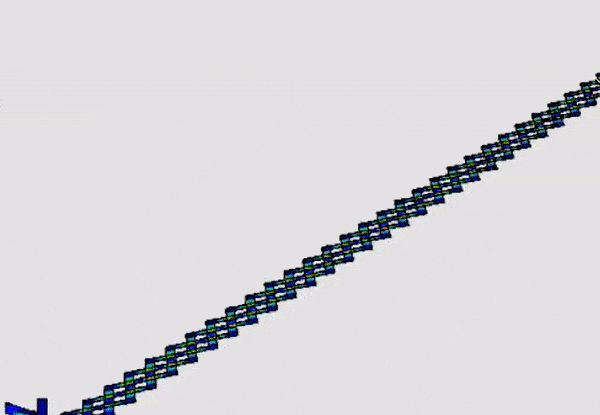Finite Element Analysis of Stick Bombs
“A stick bomb is what we call a pre-stressed structure,” said Lucas Allegrette, a junior in mechanical engineering. “We assemble the geometry of the sticks so that strain energy is holding them together. When we remove one stick, that strain energy turns into kinetic energy, and the stick bomb explodes.”
Pre-stressed structures are often found in nature, such as the twigs in a bird’s nest that are held together with strain energy. There are also microscopic examples of molecular structures that demonstrate the same geometry. Thomas Siegmund, professor of mechanical engineering and expert in solid mechanics, received a grant from the National Science Foundation to model these microscopic configurations using macroscopic materials, and he invited Lucas to be a part of his research.
“This was a new experience for me,” said Allegrette. “I had never built a stick bomb before, and I didn’t have any experience using finite element analysis. But the research was so interesting, I decided to go for it.”
Lucas started with the basics: a frame bomb, where a small number of sticks are held in place in the shape of a square, a triangle, or a star. After watching YouTube videos to learn how to build them, Lucas then undertook building a finite element analysis model of the frame bomb using Abaqus software. “First I modeled a single stick,” said Allegrette, “And then I arranged them in this lattice structure so they overlap. The model clearly showed that along undeformed regions of the sticks, there was very little strain; but in highly deformed regions like the center, there was a large amount of strain.”
 Then he moved on to a more complex pattern, the cobra weave. “The cobra weave is a long chain of sticks that are interconnected,” explained Allegrette. “When you release a stick at one end, it actually creates a wave that travels from one end of the stick bomb to the other. We were able to measure and quantify these wavelike properties.”
Then he moved on to a more complex pattern, the cobra weave. “The cobra weave is a long chain of sticks that are interconnected,” explained Allegrette. “When you release a stick at one end, it actually creates a wave that travels from one end of the stick bomb to the other. We were able to measure and quantify these wavelike properties.”
The finite element analysis revealed an important ingredient in a cobra weave stick bomb: gravity. “Unlike a frame bomb that just flies apart, the cobra weave’s strain energy actually lifts itself up off the ground,” said Allegrette. “Then the sticks fall to the ground as the reaction moves forward. That’s why it looks like a wave, and that’s also why introducing gravity in the simulation was so important.”
With the support of Professor Siegmund, Allegrette took his research to the International Mechanical Engineering Congress & Exposition, a research conference organized by the American Society of Mechanical Engineers in November 2019. His stick bomb poster was awarded both “Most Attractive Poster” and “Most Informative Poster.” “I think doing research as an undergraduate is a great opportunity,” said Allegrette. “Professor Siegmund taught me how to document my research, keep track of my data, find appropriate sources, and present to others.”
“You wouldn’t expect that a children’s toy, like a stick bomb, could be related to molecular microstructures,” said Allegrette. “You’d be surprised how well you can relate two dissimilar things, and find something out about the world.”
Writer: Jared Pike, 765-496-0374, jaredpike@purdue.edu
Source: Thomas Siegmund, 765-494-9766, siegmund@purdue.edu
This material is based upon work supported by the National Science Foundation under Grant No. 1662177, Mechanics of Topologically Interlocked Stereotomic Material Systems. This also builds upon research from Purdue undergraduate students Akanimoh Udombeh and Mukul Sawant.
